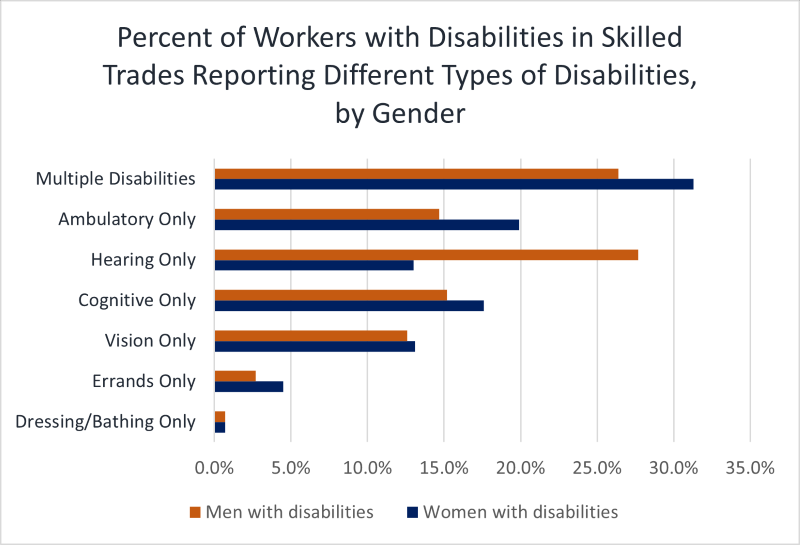Data Spotlight: Employment of Women with Disabilities in Skilled Trade Professions
How many women with disabilities are working in skilled trade positions?
As we’ve stated before, a core goal of the Biden Administration’s Good Jobs Initiative is to increase equitable pathways to good jobs in infrastructure for underrepresented groups, including women, people of color and individuals with disabilities. Supporting this goal requires an understanding of these groups’ representation in skilled trade professions, which are critical to infrastructure work.
In this spirit, we analyzed Census data on women with disabilities working in skilled trade professions and compared them to those of men with disabilities working in skilled trades. For background purposes, skilled trade jobs include the following major occupation groups:
- Farming, Fishing and Forestry
- Construction and Extraction
- Installation, Maintenance and Repair
- Production
- Transportation and Material Moving
As with our previous analysis, which focused on the Employment of Black Workers with Disabilities in Skilled Trade Professions, these data were extracted from the Census Bureau’s American Community Survey for 2017 through 2021. The industry codes are derived from the Standard Occupational Classification System, which is a federal statistical standard used to group workers into different occupations based on job titles.
How many women with disabilities are working in skilled trades?
Among disabled women in the workforce, 10.2% (approximately 455,000) are working in skilled trade professions. Larger percentages of disabled and non-disabled men are working in skilled trades compared to disabled and non-disabled women. For both men and women, a slightly higher percentage of workers with disabilities are working in skilled trades compared to those without disabilities.

What categories of skilled trades professions are most common among women with disabilities?
Most women with disabilities working in skilled trades are working in Transportation (47%) and Production (43%). Most men with disabilities working in skilled trades are working in Transportation (36%) and Construction/Extraction/Agriculture (25%).


What types of disabilities are common for disabled women working in skilled trades?
Most women with disabilities working in skilled trades report having multiple disabilities (31.3%). Of women with disabilities working in skilled trades who report only one disability, the most common is ambulatory difficulties (19.9%). In contrast, for men with disabilities working in skilled trades, the most commonly reported disability is hearing loss only (27.7%).

What is the age distribution for disabled women working in skilled trades compared to disabled men working in skilled trades?
Most disabled women working in skilled trades are ages 55-64. Combined across all age groups, disabled men working in skilled trades outnumber disabled women working in skilled trades by a ratio of more than four to one.

What industry categories are most common for women with disabilities working in trades?
A detailed look at the distribution of trade professions across different industries using the North American Industry Classification System (NAICS) shows that most women with disabilities working in trades are working in the Manufacturing, Trade and Services industries.

How do wages compare for disabled women versus non-disabled women working in skilled trades and non-trade professions?
Disabled women earn less than non-disabled women in both skilled trades and non-trade professions; however, this gap is slightly narrower for trade professions compared to non-trade professions. Note: These data include employees who are full-time (usually worked at least 35 hours per week), worked at least 50 weeks in the last year and have positive earnings.

How do wages compare for women versus men with disabilities working in skilled trades and non-trade professions?
Across all job categories of both skilled trades and non-trade professions, disabled men earn more than disabled women. These wage gaps are slightly larger than those noted previously between disabled women versus non-disabled women. Note: These data include employees who are full-time (usually worked at least 35 hours per week), worked at least 50 weeks in the last year and have positive earnings.

David Rosenblum is a senior economist and Alexandra Ruth is a data scientist in the department’s Office of Disability Employment Policy.
McGinnis.Laura…
Tue, 03/21/2023 – 09:05


Comments are closed.